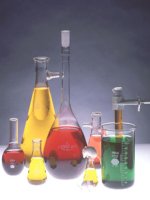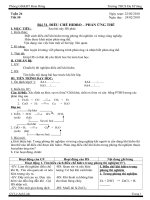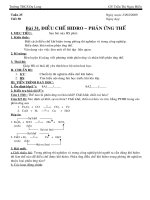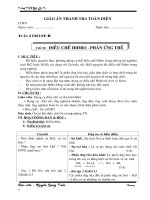Phản ứng thế
Bạn đang xem bản rút gọn của tài liệu. Xem và tải ngay bản đầy đủ của tài liệu tại đây (2.66 MB, 49 trang )
Chapter 10
Substitution Reactions
of Alkyl Halides
Organic Chemistry
4
th
Edition
Paula Yurkanis Bruice
Irene Lee
Case Western Reserve University
Cleveland, OH
©2004, Prentice Hall
What is a substitution reaction?
The atom or group that is substituted or eliminated in
these reactions is called a leaving group
Alkyl halides have relatively good leaving groups
How do alkyl halides react?
RCH
2
X
X= F, Cl, Br, I
Nu:
-
+
C X C Nu
+ X
-
δ
+
δ
-
δ
+
δ
-
Alternatively …
Nu:
-
+
C X C+
δ
+
δ
-
+ X
-
C+
C Nu
Because a nucleophile substitutes for the halogen, these
reactions are known as nucleophilic substitution reactions
The reaction mechanism which predominates depends
on the following factors:
•
the structure of the alkyl halide
•
the reactivity of the nucleophile
•
the concentration of the nucleophile
•
the solvent of the reaction
The Mechanism of an S
N
2 Reaction
Consider the kinetic of the reaction:
CH
3
Br + OH
–
CH
3
OH + Br
–
Rate = k[alkyl halide][nucleophile]
a second-order reaction
Three Experimental Evidences Support
an S
N
2 Reaction Mechanism
1. The rate of the reaction is dependent on the
concentration of the alkyl halides and the nucleophile
2. The rate of the reaction with a given nucleophile
decreases with increasing size of the alkyl halides
3. The configuration of the substituted product is
inverted compared to the configuration of the reacting
chiral alkyl halide
Why does the nucleophile attack from the back side?
A bulky substituent in the alkyl halide reduces the
reactivity of the alkyl halide: steric hindrance
Reaction coordinate diagrams for (a) the S
N
2 reaction of
methyl bromide and (b) an S
N
2 reaction of a sterically
hindered alkyl bromide
Inversion of configuration (Walden inversion) in an S
N
2
reaction is due to back side attack
S
N
2 Reactions Are Affected by the
Leaving Group
The weaker the base, the better it is as a leaving group
Carbon and iodide have the same electronegativity
Why is RI the most reactive?
Large atoms are more polarizable than small atoms
The high polarizability of a large iodide atom causes it to
react as if it were polar
The Nucleophile Affects an S
N
2 Reaction
Nucleophilicity is a measure of how readily a
compound (a nucleophile) is able to attack an
electron-deficient atom
Nucleophilicity is measured by a rate constant (k)
UNLIKE
Basicity is a measure of how well a compound (a base)
shares its lone pair with a proton
Basicity is measured by the acid dissociation constant
(K
a
)
When comparing molecules with the same attacking atom
stronger base,
better nucleophile
weaker base,
poorer nucleophile
OH
–
> H
2
O
CH
3
O
–
> CH
3
OH
–
NH
2
> NH
3
CH
3
CH
2
NH
–
> CH
3
CH
2
NH
2
When comparing molecules with attacking atoms of
approximately the same size,
When comparing molecules with attacking groups that
are very different in size,
more bonding
little bonding









